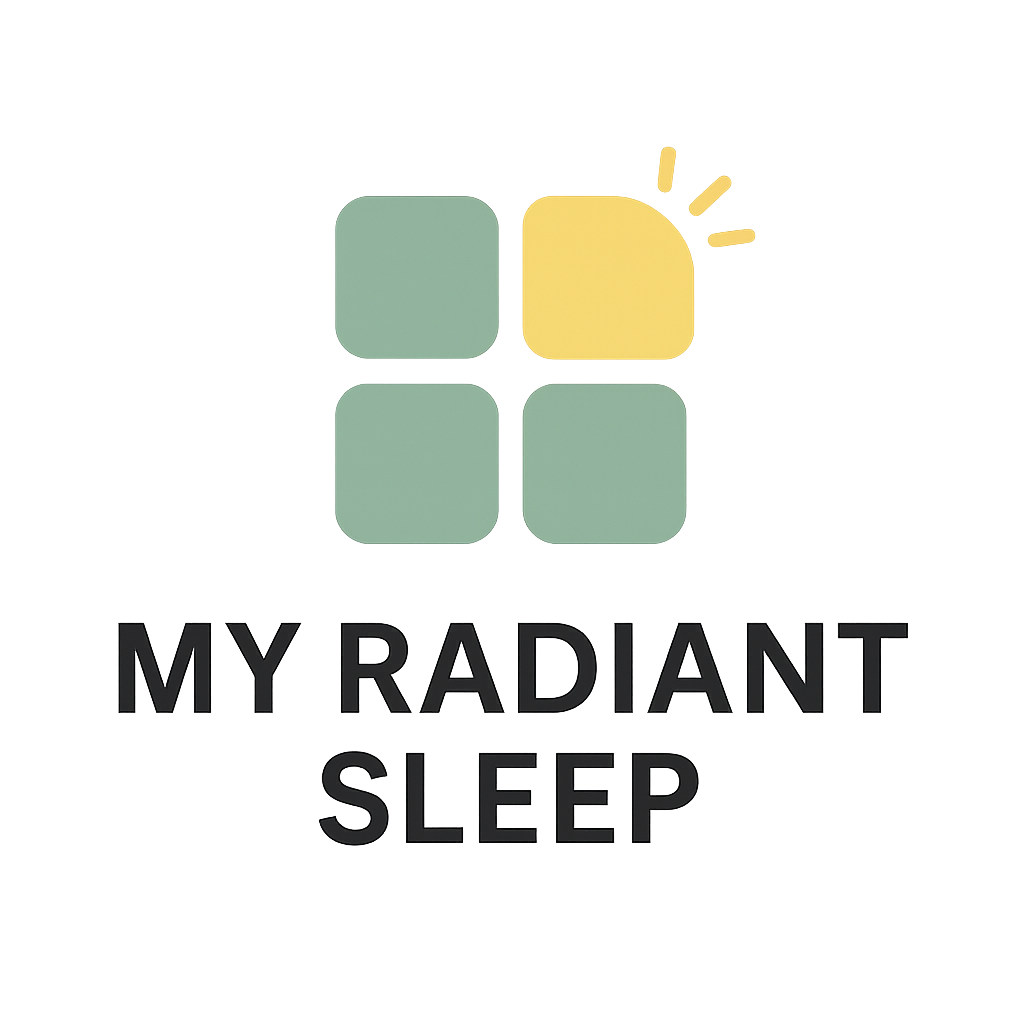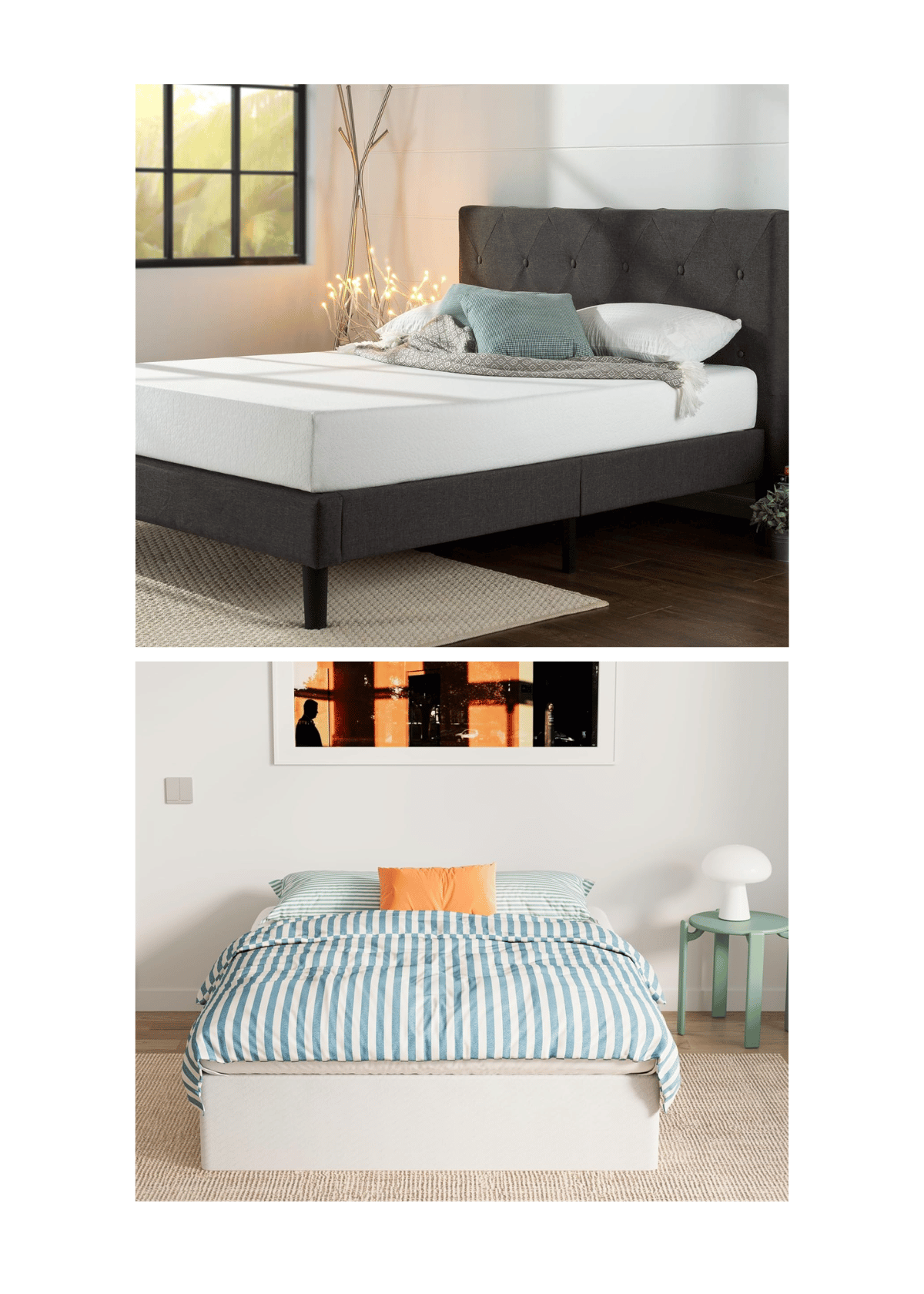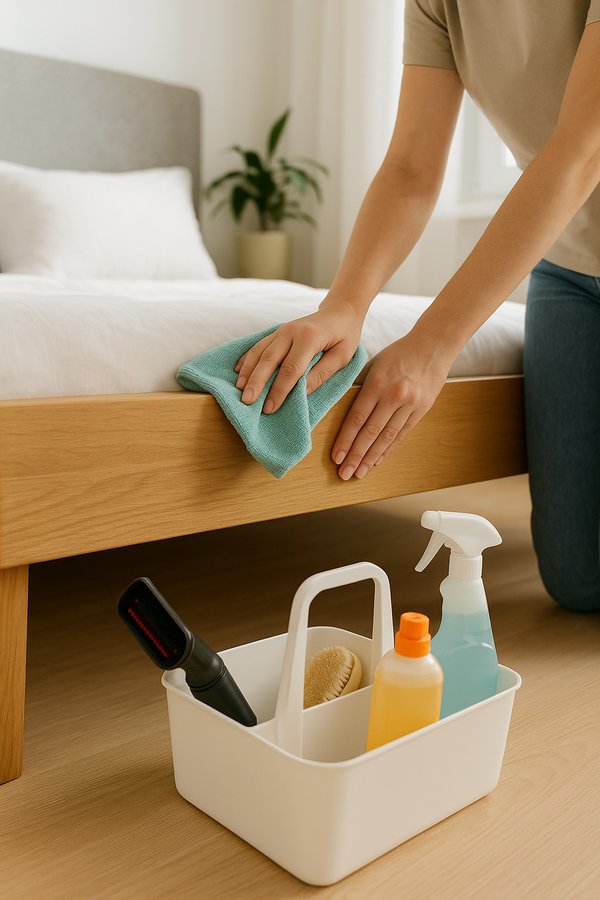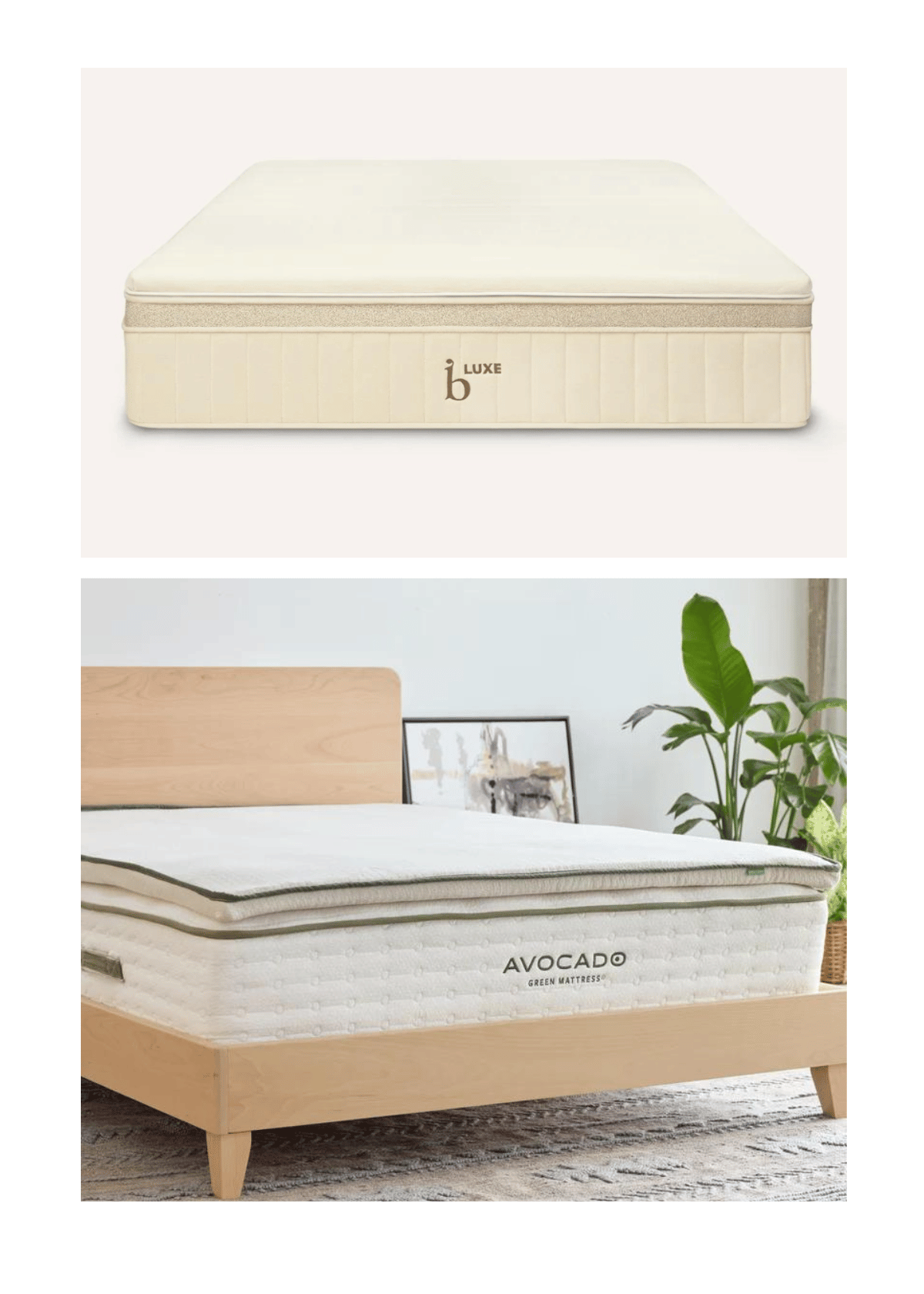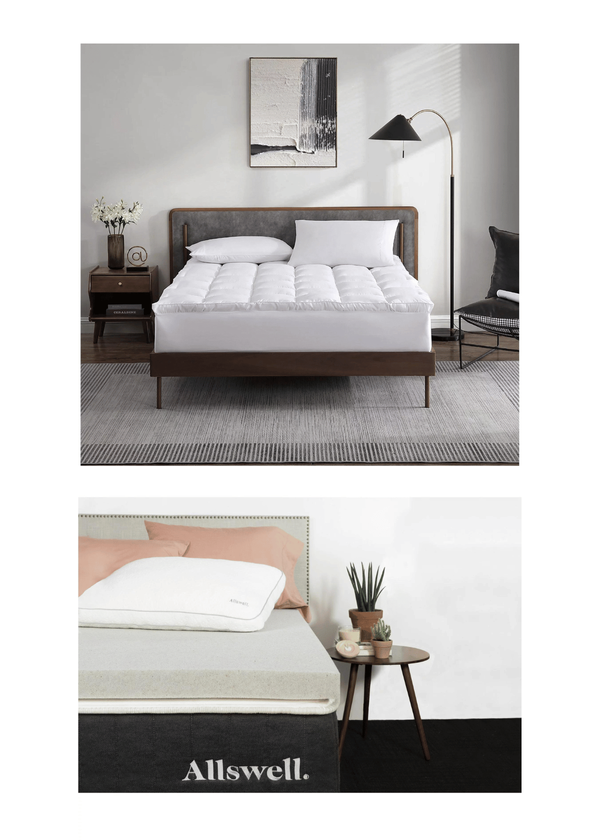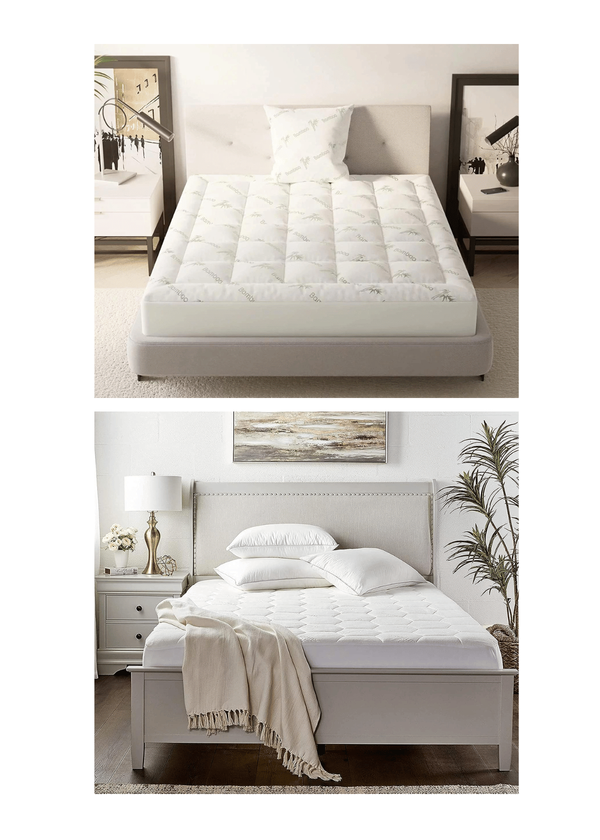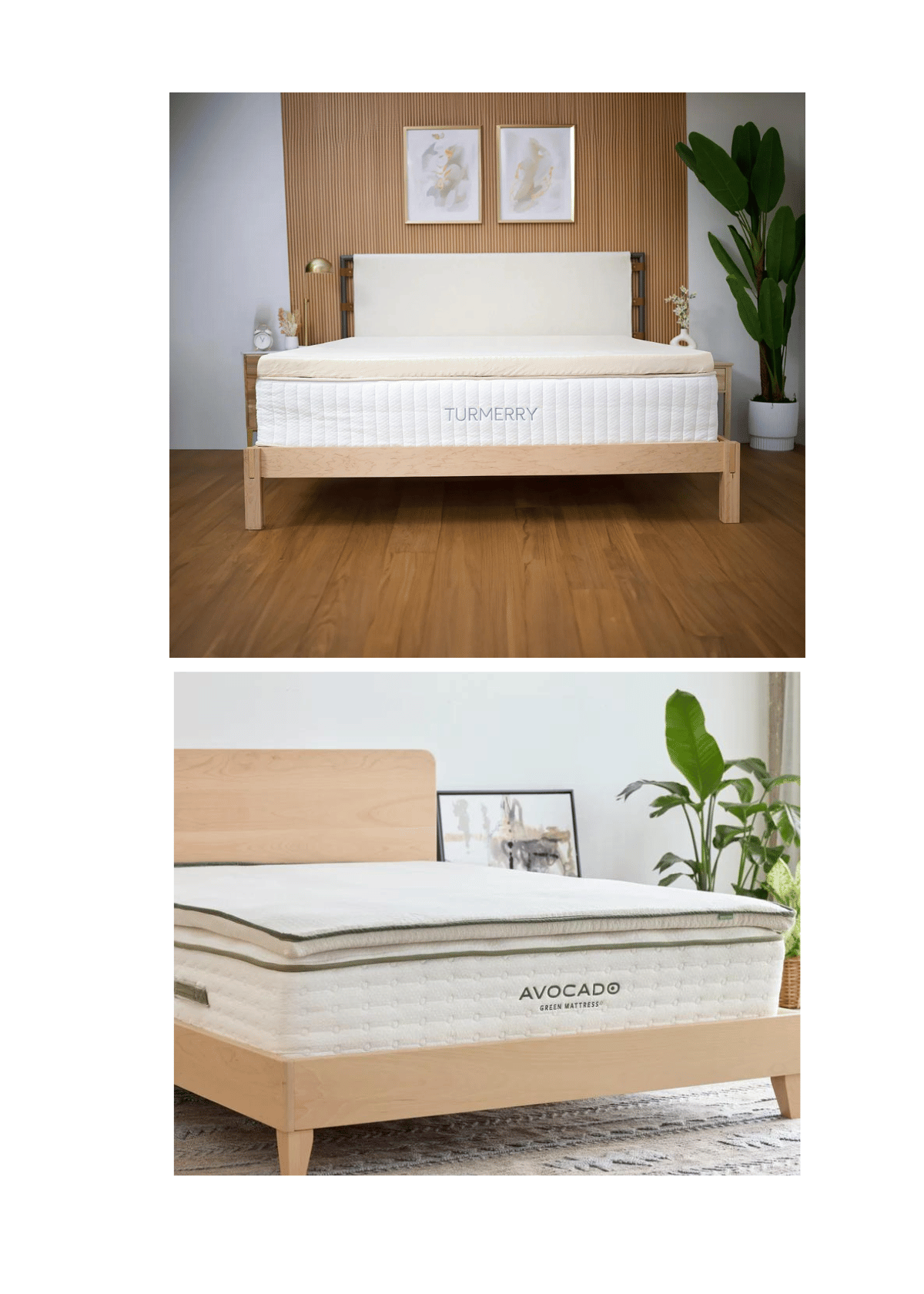(Last Update: 05/17/2025)
Are you struggling to fall asleep or waking up with aches and pains? The problem could be beneath you: you may have the wrong mattress.
A much-improved quality of your mattress affects the comfort of your sleep. Your mattress is pivotal in your sleep quality and can make all the difference in your overall health.
Imagine waking up refreshed, rejuvenated, and ready to conquer the day - every day. A well-chosen mattress can only optimize sleep and bring you one step closer to this reality.
Please read on as we explore how mattresses impact sleep quality, how to choose the right one for your needs, and the best practices for mattress maintenance to help you.
SECTION 1: SLEEP QUALITY AND YOUR MATTRESS
What Makes Deep sleep?
Deep sleep is more than just the hours you spend in bed. It encompasses several key factors.
First, it involves the consistency of your sleep schedule, meaning you go to bed and wake up around the same time every day. Second, it includes sleep efficiency, the percentage of time you sleep in bed. Ideally, you should sleep for at least 85% of your time in bed.
Third, good sleep quality involves cycling through all the stages of sleep in appropriate proportions, including light sleep, deep sleep, and REM (Rapid Eye Movement) sleep. Each stage plays a vital role in mental and physical recovery and rejuvenation.
Deep sleep means falling asleep correctly, waking up feeling refreshed, and staying alert throughout the day. It is vital for optimal cognitive functioning, mood regulation, restorative sleep health, and well-being.
The Wrong Mattress Can Cause Lasting Issues
Sleeping on a bad mattress can lead to chronic back pain, reduce total sleep time, and worsen sleep problems over time.
Most mattresses break down within 10 years, so failing to replace them regularly may disrupt your sleeping style and even contribute to pain upon waking.
Effects of Poor Sleep
Conversely, resting on the wrong mattress will provoke poor sleep quality, harming physical and mental health. Studies have shown persistent sleep deprivation can lead to obesity, heart disease, and diabetes. It also weakens the immune system, making you more susceptible to infections.
- On the mental health side, poor sleep can lead to mood disorders like depression and anxiety.
- It affects cognitive processes such as attention, memory, and decision-making. The age of your mattress affects its ability to relieve aches and pains. Besides, washing sheets and pillowcases frequently help you sleep soundly and wake up feeling refreshed.
Support Core and Mattress Type Matter
The type of mattress and its support core are crucial for spinal alignment and pain reduction. An extra firm option may help back sleepers, but side sleepers often need more cushioning. Matching your mattress to your sleeping style ensures proper support and healthier rest.
Long-Term Effects on Sleep and Health
Poor mattress quality can seriously impact sleep quality and how you wake up feeling each day.
Choosing a mattress that supports chronic back pain relief and allows for deeper rest is essential to avoid ongoing discomfort and improve your overall physical and mental well-being.
To fully benefit from a supportive mattress, your bedding should also promote airflow and comfort. Consider upgrading with these breathable percale bed sheets for 2024, designed to improve temperature regulation and sleep hygiene.
SECTION 2: TOP MATTRESSES TO IMPROVE YOUR SLEEP QUALITY
Innerspring Mattresses
Innerspring mattresses are a classic choice. They use a core of metal coils to provide robust support, often topped with padding or foam layers. These coils deliver a comfortable sleeping surface.
Construction and Support
A spring mattress is built with a core of steel coils, which can vary in type and gauge. The coils provide the mattress's main support, and their arrangement affects its overall feel and durability.
- Types of Coils:
- Bonnell coils: Hourglass-shaped and interconnected for firm support.
- Pocketed coils: Individually wrapped for better motion isolation.
Comfort Layers
The comfort layers of spring mattresses, crafted from various materials, including foam, latex, or fiber, are crucial in enhancing the mattress's comfort. These layers provide cushioning and contribute to a more enjoyable sleeping experience.
Common Materials:
- Polyurethane foam
- Memory foam
- Latex
CASE STUDY OF INNERSPRING MATTRESSES
Saatva Classic Mattress

- ★ 4.8 | $1,095–$2,295 – Supportive luxury for all sleepers
Main Features
- High-Quality Mattress Construction: The Saatva Classic boasts a luxury hybrid design that combines eco-friendly foam layers with a dual coil support system, ensuring comfort and support.
- Eco-Friendly Materials: Crafted to combat dust mites and reduce the buildup of dead skin cells, it promotes a healthier sleeping environment.
- Spinal Zone Technology: Engineered for optimal spinal alignment to reduce neck pain and enhance sleep quality.
- The Classic Mattress is the best mattress type for back problems, offering a Goldilocks approach to comfort level. It’s ideal for enough sleep, supporting various body types, and resolving sleep issues with its advanced design.
Pros and Cons
- Pros:
- Exceptional durability and support, maintaining its shape and comfort over time.
- Advanced temperature regulation features to keep sleepers cool.
- Resistance to dust mites helps in creating a cleaner sleep environment.
- Cons:
- Higher price point compared to some competitors.
- Potential for noticeable motion transfer, which might affect light sleepers.
MY BOTTOM LINE:
The Saatva Classic is celebrated for significantly improving sleep quality. It is a top choice for those seeking relief from an uncomfortable mattress and neck pain. Its balanced support and luxurious comfort cater to a wide range of sleepers, earning it high marks in customer satisfaction.
A mattress can only do so much if your pillow doesn't support cervical alignment. Discover how Saatva pillows relieve back and neck pain and enhance overall spinal posture during sleep..
Memory Foam Mattresses
Memory foam mattresses provide exceptional contouring and tension relief. They are made from viscoelastic foam. It responds to heat and pressure, molding to the shape of the sleeper's body.
Material and Construction
Foam mattresses have multiple layers of foam, each designed to provide specific levels of comfort and support. The top layer is usually softer and more responsive, while the lower layers provide more support and durability.
- Layer Composition:
- Comfort layer: Soft and responsive foam.
- Transition layer: Slightly firmer foam to provide support.
- Base layer: High-density foam for stability and durability.
Pressure Relief and Support
Memory foam excels in stress relief by evenly distributing weight and reducing stress points. This feature makes it an excellent selection for individuals with joint pain or needing extra support.
- Pressure Relief Benefits:
- Reduces pressure on joints
- Minimizes tossing and turning
Temperature Regulation
One common issue with memory foam is heat retention. However, many modern foam mattresses incorporate cooling technologies, such as gel-infused foam or open-cell structures, to enhance airflow and dissipate heat.
- Cooling Technologies:
- Gel-infused memory foam
- Open-cell foam structure
Modern sleep science has introduced powerful innovations—like smart mattresses and sleep technology—that monitor sleep quality and help improve health through real-time insights and adjustability.
CASES STUDY OF MEMORY FOAM MATTRESSES
NECTAR PREMIER MATTRESS
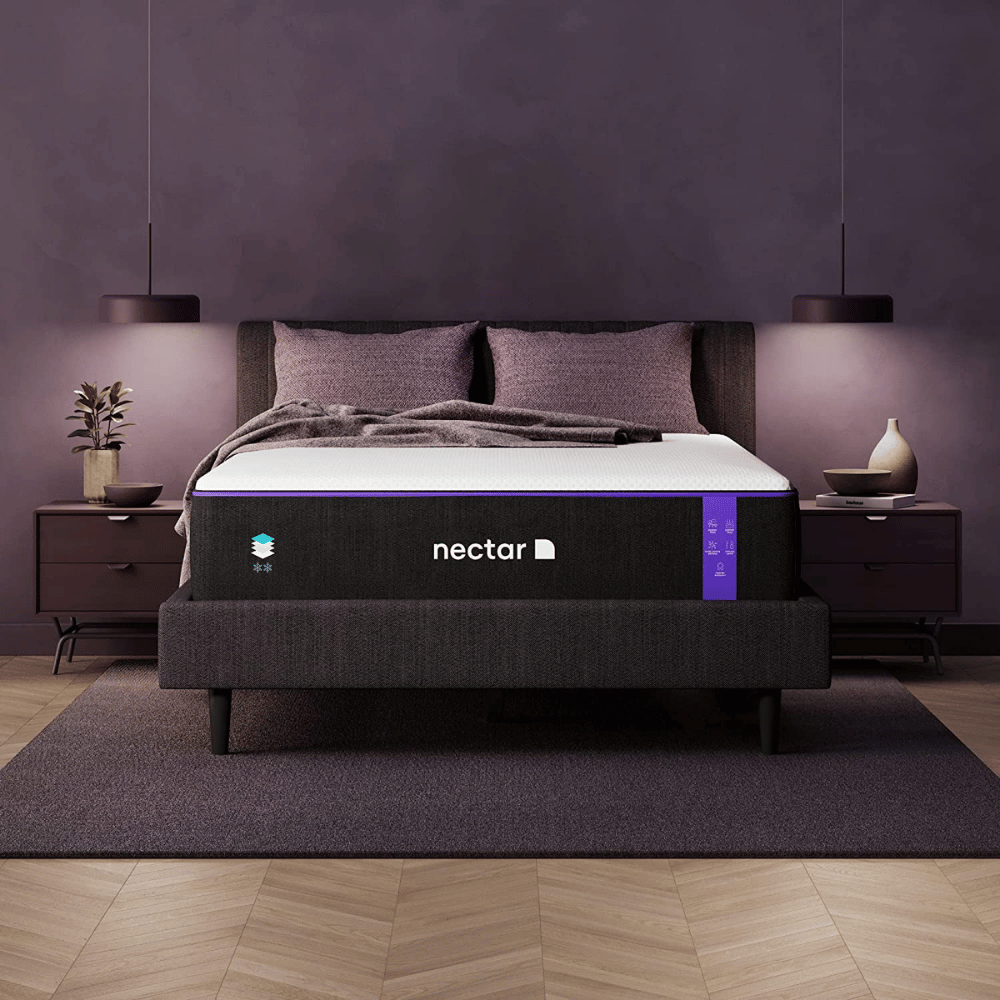
- ★ 4.7 | $999–$1,949 – Gel foam with deep stress relief
Main Features:
- Sturdy Structure: A mattress's firmness level affects stress points. The Nectar Premier Mattress is known for its five-layer construction, featuring a cooling cover, gel foam, and high-density base foam.
- It incorporates advanced cooling technology to regulate temperature and ensure comfortable sleep.
- The mattress ensures sufficient sleep and is perfect for a comfortable night, easily accommodating different body types. It's a great option for buying a new mattress to replace your current one.
Pros and Cons:
- These medium-firm mattresses cater to all types of sleepers.
- Back sleepers will appreciate its firm support, side sleepers will enjoy stress relief at shoulders and hips, and stomach sleepers will benefit from the even surface that maintains a spine alignment.
MY BOTTOM LINE:
The medium-firm Mattress perfectly balances firm support and soft comfort. Its cooling technology and high-quality materials place it among the best memory foam mattresses on the market. Another big plus is that it suits all sleeping positions.
DreamCloud Premier Memory Foam Mattress
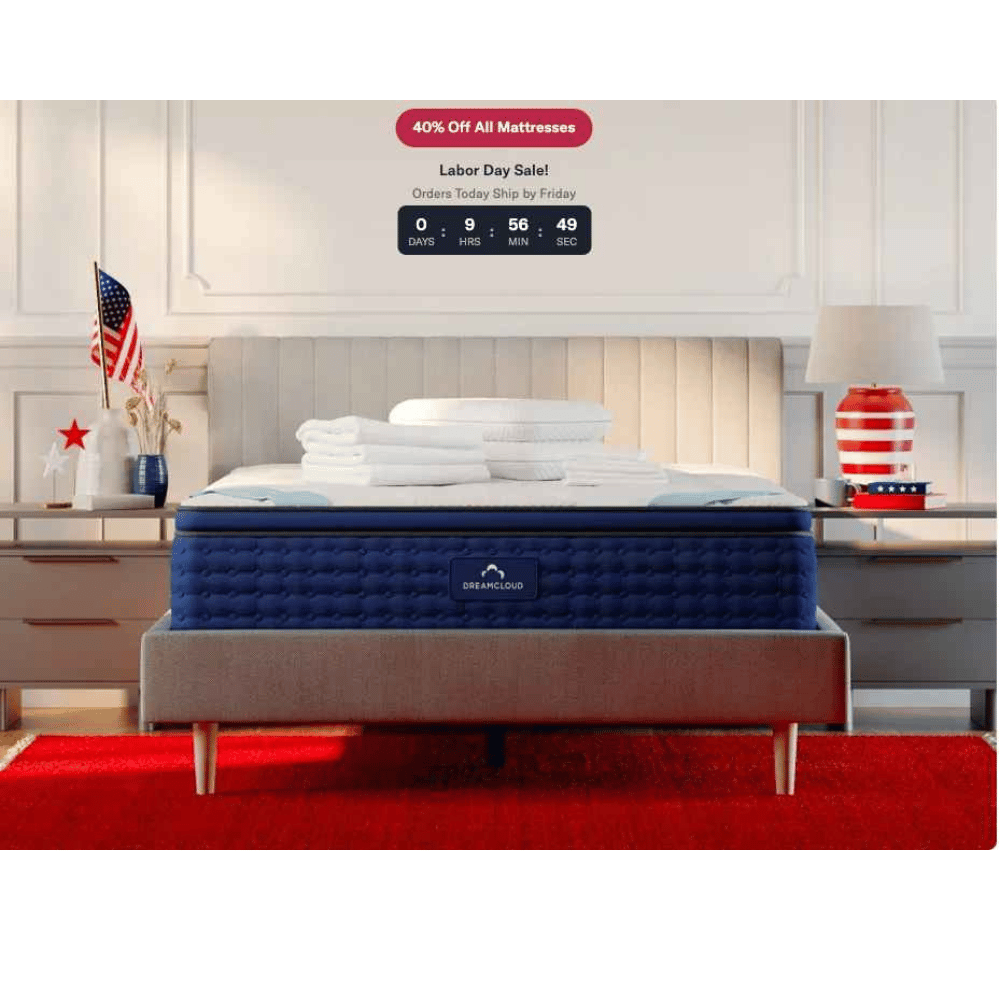
- ★ 4.7 | $799–$1,699 – Luxury hybrid with plush contour and support
Main Features
- All-Memory Foam Construction: This mattress offers a plush, contouring feel that adapts to your body and supports various sleep positions.
- Cooling Technologies: Integrated cooling gel and a breathable cover help regulate temperature, keeping sleepers cool.
- Pressure reduction: This product is designed to alleviate stress points, ensuring a comfortable night’s sleep for all, including women who've reported it helps improve sleep quality.
- The Foam mattress provides an exceptional comfort level, addressing back and neck issues. It’s among the best mattresses, offering sufficient sleep for various body types.
Pros and Cons
- Pros:
- Excellent for multiple sleep positions, providing versatility and comfort for everyone.
- Enhanced pressure relief, beneficial for reducing discomfort and improving sleep quality.
- Cooling features help manage body temperature, preventing overheating.
- Cons:
- May be too soft for those who prefer a firmer support level.
- Memory foam can absorb heat, though mitigated by cooling technologies.
MY BOTTOM LINE:
The DreamCloud Premier Foam Mattress is considered one of the best mattresses because it offers personalized comfort and support across various sleep positions for the best night's sleep. Its all-memory foam construction, coupled with cooling technologies.
If allergies or chemical sensitivities are affecting your rest, the Birch Mattress offers an eco-friendly, organic alternative with natural latex and breathable materials for cleaner, healthier sleep.
Latex Mattresses
Latex mattresses are engineered from natural or synthetic latex and are best for their durability, support, and responsiveness. They provide a balance of comfort and support, making them a popular choice for many sleepers.
Types of Latex
Two main types of latex are used in mattresses: natural latex and synthetic latex. Natural latex is made from the sap of rubber trees, while synthetic latex is made from petrochemicals.
- Natural latex: Eco-friendly and highly durable.
- Synthetic latex: More affordable but less durable.
Comfort and Support
Latex beds offer a responsive and supportive sleep area. Their combination of firmness and cushioning helps maintain proper spinal alignment while providing comfort.
- Supportive Features:
- Excellent contouring without the "sink-in" feel of memory foam.
- Natural buoyancy for easy movement.
Durability and Longevity
Latex mattresses are known for longevity, often lasting longer than other mattresses. They resist sagging and can maintain their supportive properties for many years.
- Durability Benefits:
- Long-lasting performance
- Resistant to dust mites and mold
Your sleeping position plays a crucial role in mattress effectiveness. Use this mattress and sleep position guide to match the right firmness and materials to your preferred way of sleeping.
CASE STUDY OF LATEX MATTRESSES
PlushBeds Botanical Bliss
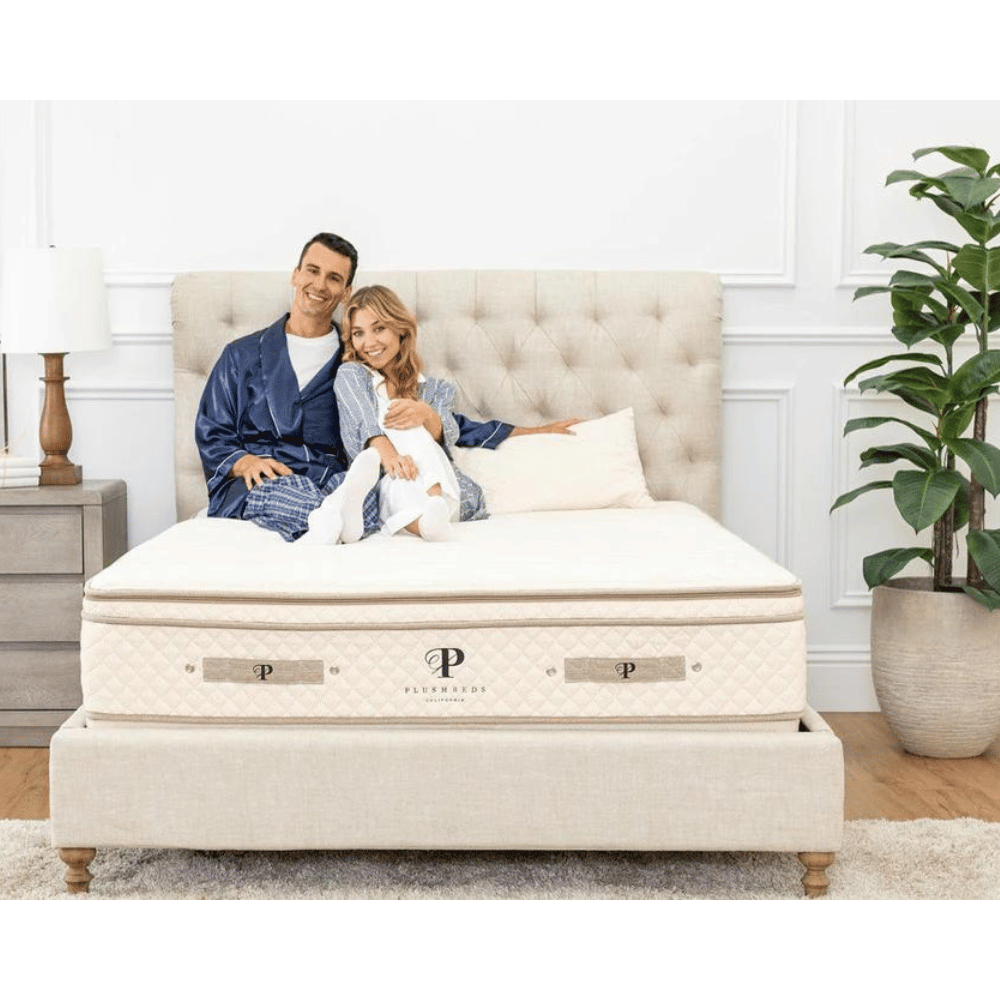
- ★ 4.6 | $1,399–$2,799 – Organic latex with breathable, customizable firmness
Main Features
- Organic Materials: The PlushBeds Botanical Bliss is crafted with 100% organic latex, cotton, and wool, ensuring a natural and chemical-free sleep environment.
- Customizable Firmness: The latex mattress offers customizable firmness levels to accommodate different sleep positions, enhancing comfort for a broad range of sleepers.
- Temperature Regulation: Natural latex and wool work together to regulate body temperature, keeping sleepers cool throughout the night.
- The PlushBeds Botanical Bliss mattress is perfect for those seeking the best mattress for back problems. It ensures sufficient sleep and addresses sleep issues, supporting the human body comfortably.
Pros and Cons
- Pros:
- Superior comfort and support for various sleep positions.
- Organic materials contribute to a healthier sleep environment.
- Excellent temperature regulation helps sleepers stay asleep by avoiding overheating.
- Cons:
- Premium materials and customization options come with a higher price tag.
- The mattress's weight and density might make it challenging to move or adjust without assistance.
MY BOTTOM LINE:
The PlushBeds Botanical Blissias one of the best mattresses, especially for those seeking an eco-friendly and health-conscious sleep solution. Its combination of organic materials and customizable firmness levels improves sleep quality for many individuals.
If you frequently wake up hot or damp, your mattress might be the culprit. Uncover the causes and solutions in this guide to mattresses and night sweats.
WinkBeds EcoCloud mattress
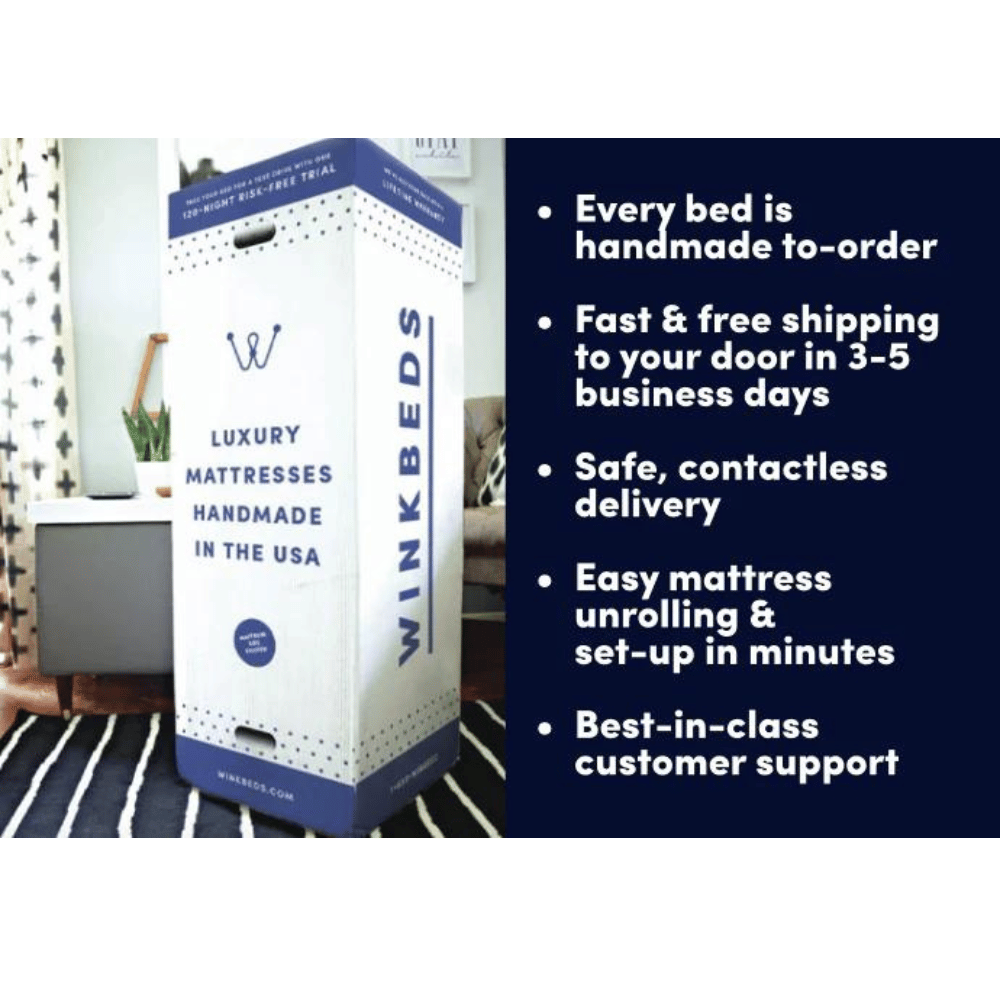
- ★ 4.6 | $1,199–$2,199 – Eco-conscious hybrid with zoned lumbar support
Main Features
Hybrid Design: The WinkBeds EcoCloud is a hybrid, blending the responsive support of innerspring coils with the comfort of a Talalay latex foam layer.
- Eco-Friendly Materials: Crafted with natural and organic materials that ensure the mattress promotes a healthier sleep environment.
- Zoned Support System: The latex mattress is engineered to distribute weight evenly across the mattress, providing adequate support for various sleep positions.
- The WinkBeds EcoCloud mattress is designed for sufficient sleep, catering to different body types and alleviating sleep issues. It’s a top choice for a new mattress with a superior comfort level.
Pros and Cons
- Pros:
- Exceptional support for different body types and sleep positions.
- Eco-friendly construction helps regulate body temperature for a cooler sleep.
- Compatible with any bed frame, enhancing versatility.
- Cons:
- Price point may be higher than average, reflecting its quality and eco-friendly materials.
- The responsiveness of the mattress might not suit those used to traditional memory foam mattresses.
MY BOTTOM LINE:
The WinkBeds EcoCloud mattress is one of the best mattresses due to its exceptional balance of comfort, support, and eco-conscious construction. It stands out for its ability to distribute weight evenly.
Hybrid Mattresses
Hybrid mattresses mix the features of innerspring and foam mattresses to provide a balanced sleep experience. They typically have a coil support system topped with foam or latex layers for comfort.
Construction and Materials
Hybrid mattresses are constructed with a core of pocketed coils and multiple layers of foam or latex. This combination offers the support of an innerspring mattress with the contouring and tension relief of foam or latex.
- Layer Composition:
- Coil support system: Pocketed coils for support and motion isolation.
- Comfort layers: foam, latex, or polyfoam for added cushioning.
Comfort and Support
Hybrid mattresses provide a good balance of support and comfort. The coils offer sturdy support and responsiveness, while the foam or latex layers provide pressure reduction and contouring.
Comfort Features:
- Balanced support and contouring
- Enhanced airflow and cooling
Temperature Regulation
Hybrid mattresses often incorporate cooling technologies to counteract the heat retention of foam layers. The coil system also promotes airflow, helping to maintain a cooler sleep environment.
- Cooling Technologies:
- Gel-infused foam layers
- Breathable coil structure
If you struggle with finding the right firmness for your back or sleep style, a flippable mattress with dual comfort levels can be an ideal solution to support your evolving sleep needs over time
CASE STUDY OF HYBRID MATTRESSES
Helix Midnight Mattress
Main Features
- Hybrid Design: Combines foam with individually wrapped coils for a balance of comfort and support.
- Medium Firmness: Medium firm beds offer the perfect balance of support and comfort, making them ideal for various sleep positions. They provide a 'just right' feel, catering to those who need a versatile mattress for a good night's rest.
- Cooling Technology: Features a breathable cover and cooling foam layers to help regulate body temperature.
- The Mattress offers a Goldilocks approach to comfort, making it one of the best back and neck support mattresses. It provides sufficient sleep, suitable for various body types.
Pros and Cons
- Pros:
- Excellent support for side sleepers, making it one of the best mattresses for those who prefer sleeping on their side.
- Adapts well to various body types, ensuring women and men sleep comfortably.
- Cooling technology helps keep sleepers cool, addressing the common overheating issue.
- Cons:
- May not be firm enough for those who prefer a very firm mattress.
- Motion isolation is good but might not satisfy the most sensitive sleepers.
MY BOTTOM LINE:
The Helix Midnight Mattress earns its place as a top-rated mattress due to its hybrid construction that suits a variety of sleep positions and preferences. You can shop for this mattress because its ability to provide tailored support and cooling technology makes it a standout choice to ensure a comfortable sleep environment free from overheating.
TEMPUR-PEDIC TEMPUR-ADAPT 11-INCH HYBRID MATTRESS
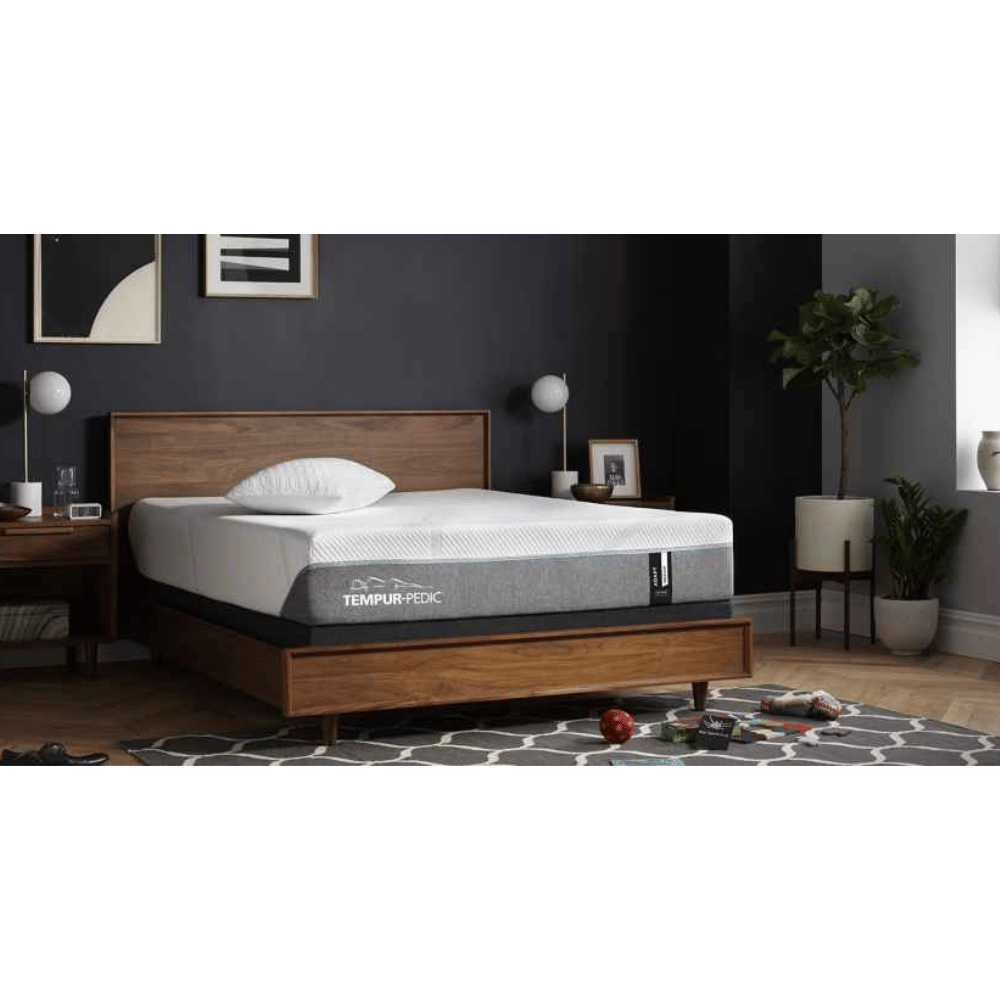
- ★ 4.5 | $1,699–$3,199 – Pressure-relieving foam and durable coil support
Main Features:
- This new mattress also combines premium spring coils with Tempur-Pedic's proprietary memory foam for a unique balance of responsiveness and support.
- It includes a cool-to-touch cover for comfortable temperature regulation during sleep.
- The Hybrid Mattress is ideal for sufficient sleep, offering excellent comfort for different body types. It effectively addresses back problems, making it the best mattress for many.
Pros and Cons:
- This hybrid design works well for all types of sleepers, with the foam providing any pressure point relief for side sleepers and the supportive coils ensuring proper alignment for back and stomach sleepers.
MY BOTTOM LINE:
The Tempur-Pedic TEMPUR-Adapt Hybrid Mattress offers the signature comfort and support of Tempur-Pedic, enhanced with the responsiveness of springs. The added benefit of the cooling cover makes it an excellent choice for those who want a cool and comfortable sleep experience.
AIR MATTRESSES
Air mattresses use air chambers as the first support system, allowing for adjustable firmness levels. They are commonly used for temporary sleeping arrangements but can also serve as permanent beds.
Construction and Materials
Air mattresses are constructed with air chambers that are inflated or deflated to adjust the firmness. They often include a layer of foam or padding for added comfort.
Material Composition:
Air chambers: Adjustable for customized firmness.
- Comfort layer: Foam or fiber padding for cushioning.
Adjustable Firmness
One of the main advantages of air mattresses is the ability to adjust firmness levels. This feature allows sleepers to customize their comfort and support.
- Adjustability Benefits:
- Customizable firmness
- Suitable for different sleep positions
Portability and Storage
Air mattresses are usually lightweight and easy to store, making them ideal for temporary use or guests. Many air mattresses come with a built-in pump for easy inflation and deflation.
- Portability Features:
- Lightweight and easy to transport
- Compact storage when deflated
CASE STUDY OF AIR MATTRESSES
KING KOIL AIR QUEEN MATTRESS WITH BUILT-IN PUMP
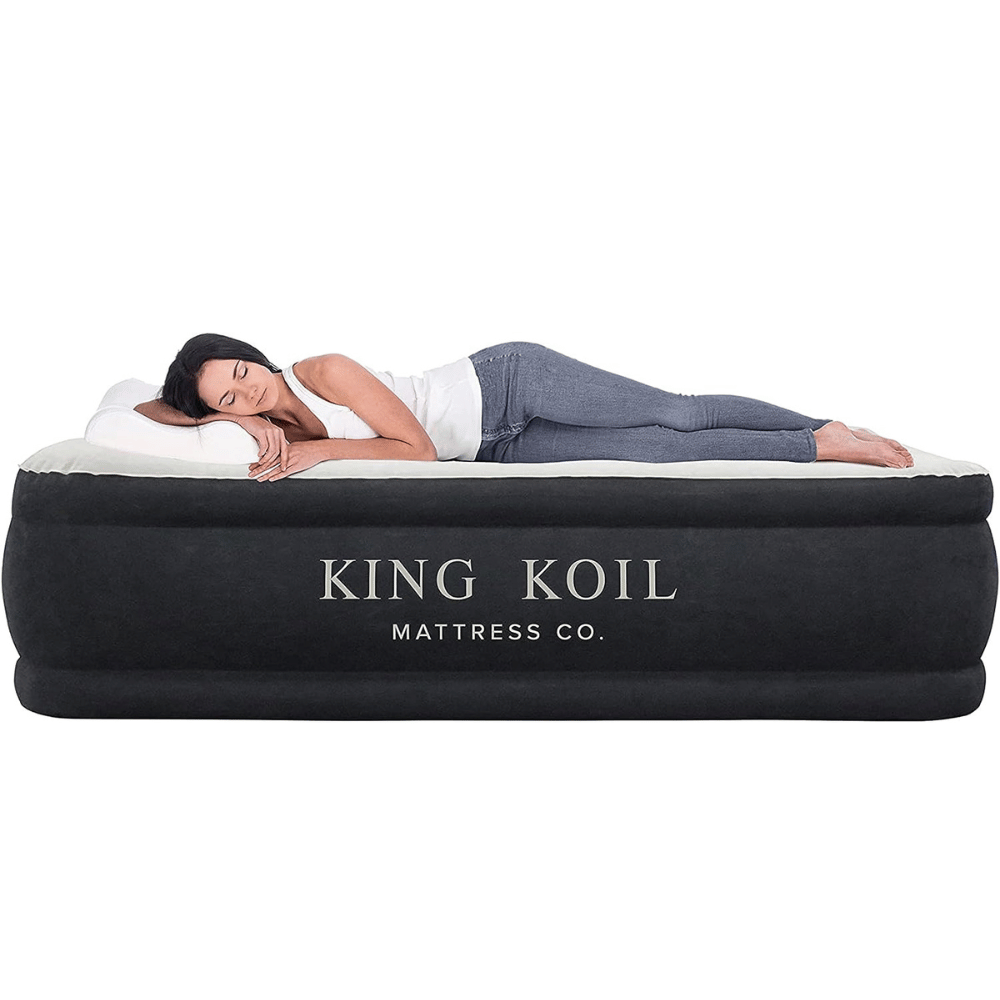
- ★ 4.4 | $120–$180 – Quick-inflate air bed with built-in pump
Main Features:
- The King Koil Air Queen Mattress features a built-in pump for easy inflation and deflation. It can be adjusted to achieve the desired firmness.
- It has a flocked top and built-in pillow for comfort and a velvety feel.
- The Air Queen Mattress provides sufficient sleep at a comfortable level that suits various body types. It’s perfect for replacing a bad mattress or for those needing a new one.
Pros and Cons:
- With adjustable firmness, it can cater to all types of sleepers. Back and stomach sleepers can inflate it to a higher level for better support, while side sleepers might prefer a softer setting.
MY BOTTOM LINE:
King Koil is known for its superior quality in the airbed market. This model's ability to adjust firmness levels and the added comfort of a flocked top and built-in pillow make it a top choice among consumers.
SOUNDASLEEP DREAM AIR MATTRESS
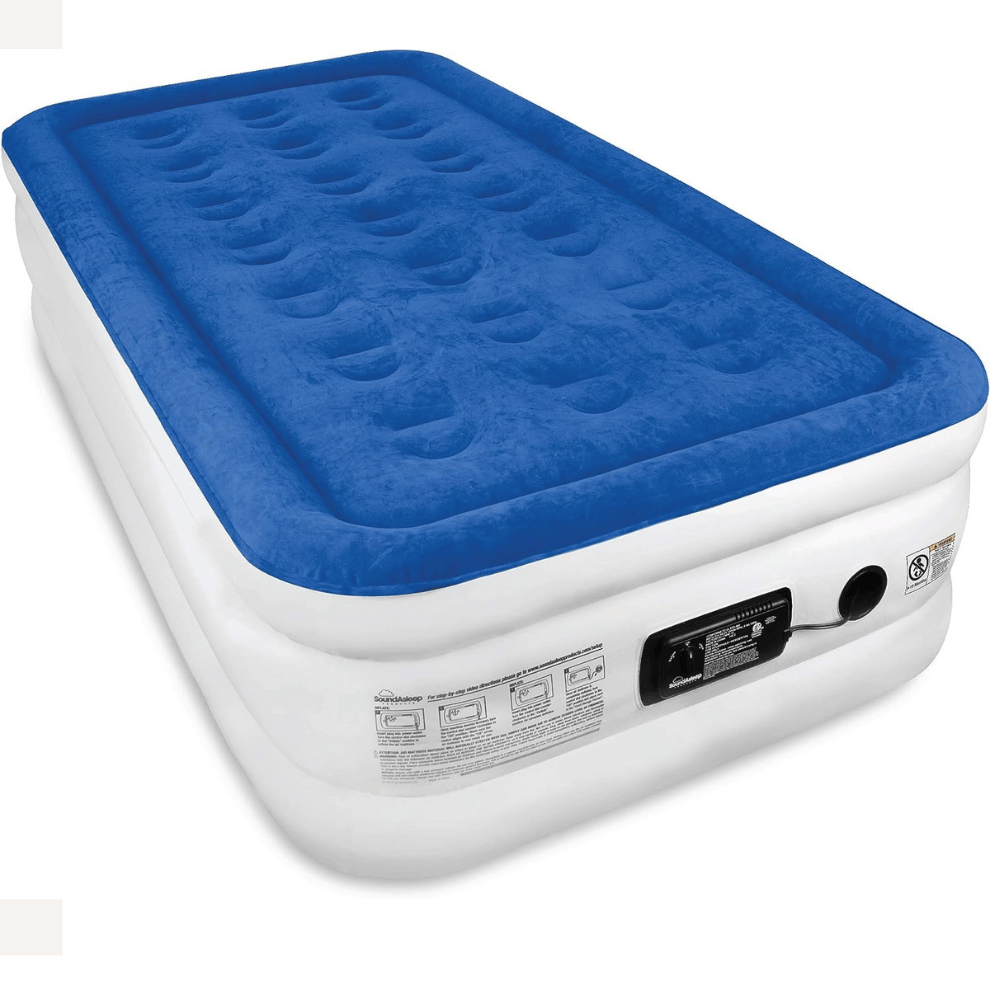
- ★ 4.5 | $80–$200 – Raised air mattress with comfort coil technology
Main Features:
- This air mattress features ComfortCoil Technology with 40 air coils for durable support and comfort.
- It includes a patented 1-click internal pump for quick and easy inflation and deflation.
- The Dream Air Mattress ensures sufficient sleep and a great comfort level. It’s ideal for resolving sleep issues and supports different body types, making it a great temporary solution.
Pros and Cons:
- Its ability to adjust firmness levels makes it suitable for all sleep styles, and the ComfortCoil technology ensures an even distribution of air for balanced support.
MY BOTTOM LINE:
The SoundAsleep Dream Series Air Mattress stands out for its ComfortCoil Technology, which enhances its overall comfort and support. The quick and convenient internal pump also receives high praise, making it a preferred choice for many.
Waterbeds
Waterbeds use water as the primary support system and are known for their unique feel and customizable firmness. They offer good pressure relief and can be heated for added comfort.
Construction and Types
Waterbeds come in two main types: hard-sided and soft-sided. Hard-sided waterbeds have a wooden frame to support the water mattress, while soft-sided waterbeds use a foam frame.
Types of Waterbeds:
Hard-sided: Traditional design with a wooden frame.
Soft-sided: Modern design with a foam frame.
Comfort and Support
Waterbeds provide excellent pressure reduction by evenly distributing weight. The water conforms to the body's shape, reducing tension points and promoting spinal alignment.
- Comfort Benefits:
- Even weight distribution
- Reduced pressure on joints
Temperature Control
Many waterbeds have temperature control systems, allowing sleepers to heat the water to their desired temperature. This feature provides an extra level of comfort, especially in colder climates.
- Temperature Features:
- Adjustable heating system
- Consistent warmth throughout the night
Ideal Sleepers
Waterbeds suit sleepers who enjoy a unique floating sensation and need excellent pressure relief. They also benefit individuals with certain medical conditions requiring customized support and temperature control.
Systematic Review: Choosing the Right Mattress for Health
A systematic review of many manufacturers reveals that mattresses significantly impact sleep quality and overall health. While mattress toppers can improve comfort, you may need help to resolve issues caused by your current mattress.
For optimal health benefits, investing in a new one that suits your body type and sleep needs is essential, providing better support and alleviating discomfort.
Mattress Firmness and Support
Understanding Mattress Firmness
Mattress firmness defines how hard or soft a mattress feels when lying on it. It is an important factor that affects overall comfort and support, impacting sleep quality and health.
Firmness Scale
Mattress firmness is assessed on a scale from 1 to 10, with 1 being extremely soft and 10 extremely firm. This scale helps consumers compare different mattresses and find one that suits their preferences.
- Soft (1-3):
- Provides a plush, sinking feel.
- It is ideal for those who like a very cushioned surface.
- Medium (4-6):
- Offers a balance of support and comfort.
- Suitable for most sleepers.
Materials and Firmness
The materials in a mattress significantly impact its firmness. Different types of foam, latex, and innerspring systems contribute to varying firmness and support levels.
- Memory Foam:
- Conforms closely to the body.
- Typically offers a softer feel.
- Innerspring:
- Uses coils for support.
- Generally firmer and more supportive.
Muscle recovery and quality rest go hand in hand. For those with an active lifestyle, explore the best mattresses for athletes that provide optimal support and pressure relief to boost recovery.
Perception of Firmness
Firmness perception can vary based on weight, size, and sleep position. Heavier individuals may perceive a mattress as softer, while lighter individuals may find it firmer.
Body Weight Impact:
- Heavier sleepers may need a firmer mattress.
- Lighter sleepers might prefer a softer mattress.
Finding the Right Firmness
Selecting the right firmness involves considering personal comfort preferences, sleeping position, and health issues, such as back pain or joint problems.
How Firmness Affects Sleep Quality
The firmness of a mattress plays an important role in determining sleep quality, influencing comfort, support, and overall sleep health.
Comfort and Firmness
A mattress that aligns with your comfort preferences helps you fall asleep faster. Comfort is subjective and varies from person to person.
Comfort Levels:
- Soft mattresses: Ideal for side sleepers.
- Firm mattresses: Better for back and stomach sleepers.
Pressure Relief
Proper mattress firmness can alleviate tension points, reducing discomfort and pain, especially in the hips, shoulders, and lower back.
- Pressure Point Reduction:
- Soft mattresses: Contour to the body, relieving pressure.
- Firm mattresses: Distribute body weight evenly.
Sleep Disruptions
An unsuitable mattress firmness can lead to frequent tossing and turning, disrupting sleep and reducing sleep quality.
- Common Issues:
- Too soft: May cause back pain due to lack of support.
- Too firm: It may cause discomfort and pressure buildup.
Long-Term Health Effects
Prolonged use of an unsuitable mattress can lead to chronic pain, poor sleep posture, and common health conditions.
- Health Impact:
- Correct firmness: Supports spinal alignment.
- Incorrect firmness: Can exacerbate pain and discomfort.
The Role of Support in Spinal Alignment
Proper spinal alignment is essential for a good night's sleep of healthy, and mattress support plays a key role in maintaining it.
Importance of Spinal Alignment
Maintaining a neutral spine during sleep helps prevent back pain and promotes overall spinal health. The spine should be aligned in its natural curve.
- Neutral Spine:
- Reduces strain on the spine.
- Prevents muscle and ligament pain.
Mattress Support Systems
Different mattress types provide many levels of support. Understanding these systems helps in selecting a mattress that maintains proper spinal alignment.
- Types of Support Systems:
- Innerspring: Uses coils to provide support.
- Foam: Offers contouring support for spinal alignment.
Impact on Different Sleep Positions
The level of support needed varies based on sleep position. Proper support ensures the spine is correctly aligned, regardless of how you sleep.
Sleep Positions:
Side sleepers: Need softer support for shoulders and hips.
Back sleepers: Require even support to maintain alignment.
Long-Term Benefits of Proper Support
Investing in a supportive mattress can lead to long-term benefits, including reduced back pain, improved posture, and better overall health.
Health Benefits:
- Prevents chronic pain.
- Promotes better sleep quality and health.
Impact of Mattresses on Specific Health Conditions
Mattresses and Back Pain
Back pain, a common problem that can significantly affect sleep quality and overall well-being, can be alleviated with the right mattress, offering hope for a good night's sleep.
Proper Support for Spinal Alignment
A mattress that offers proper support helps maintain the spine's natural alignment, crucial for preventing and reducing back pain.
Supportive Features:
- Firmness: Medium-firm mattresses are often recommended for back pain.
- Materials: Memory foam and latex are known for their contouring support.
Reducing Pressure zones
A mattress that reduces pressure points can alleviate pain in the lower back and other areas and promote better sleep posture.
- Pressure Relief:
- Even weight distribution: Prevents pressure buildup on the spine.
- Contouring materials: Provide targeted support for the lower back.
Mattress Age and Sagging
Regular maintenance and timely replacement of mattresses are crucial for maintaining a healthy sleep environment, empowering you to take proactive steps in managing back pain.
Mattresses and Joint Pain
Joint pain, including arthritis and other conditions, can be significantly influenced by the type of mattress you use. The right mattress can help reduce pain and improve sleep quality for those with joint issues.
Cushioning and Support
A mattress that provides cushioning and support helps alleviate joint pain by reducing pressure on sensitive areas.
Supportive Features:
Memory foam: Offers excellent pressure relief for joints.
Latex: Provides a responsive surface that supports joints.
Temperature Regulation
Temperature changes can affect joint pain; some mattresses offer features that help regulate temperature.
Cooling Technologies:
Gel-infused foam: Helps keep the mattress cool.
Breathable materials: Promote airflow and temperature control.
Motion Isolation
Minimizing movement on the mattress can help prevent additional discomfort for joint pain patients.
Motion Isolation:
- Memory foam: Absorbs movement and prevents disturbances.
- Hybrid mattresses: Combine motion isolation with support.
Sleep Positions and Joint Relief
For instance, sleeping on your back with a pillow under your knees can help alleviate lower back pain. Similarly, side sleepers can benefit from a pillow between their knees to reduce pressure on their hips and lower back. Finding the right sleep position and mattress combination can help alleviate joint pain.
Mattresses and Allergies
Allergies can significantly impact sleep quality, and choosing the right mattress can help reduce allergen exposure and improve overall health.
Hypoallergenic Materials
Mattresses made from hypoallergenic materials can help minimize allergic reactions by reducing exposure to common allergens.
Hypoallergenic Features:
Natural latex: Resistant to dust mites and mold.
Organic materials: Reduce chemical exposure.
Dust Mite Resistance
Dust mites are an allergen that can thrive in mattresses. Choosing a mattress with dust mite-resistant properties can help reduce allergic reactions.
Resistance Features:
Memory foam: Less hospitable to dust mites.
Encasements: Protective covers can further reduce exposure.
Breathability and Airflow
A mattress with good breathability and airflow helps prevent the buildup of allergens.
Breathable Materials:
Latex and hybrid mattresses: Promote airflow.
Moisture-wicking covers: Keep the mattress dry and reduce mold growth.
Regular Maintenance
Regularly cleaning and maintaining your mattress can also help reduce allergen buildup.
Mattresses and Asthma
People with asthma and trouble sleeping can experience better rest with a mattress designed to reduce triggers and create a more comfortable, healthy sleep environment.
Allergen Reduction
A mattress that reduces exposure to allergens can help minimize asthma triggers and improve respiratory health.
Allergen-Reducing Features:
Hypoallergenic materials: Prevent dust mites and mold.
Protective covers: It adds an extra layer of defense.
Breathability and Moisture Control
A mattress with good breathability and moisture control may help reduce the risk of mold and mildew, which can trigger asthma symptoms.
Breathable Materials:
Latex and hybrid mattresses: Promote airflow and reduce moisture.
Moisture-wicking covers: Keep the mattress dry.
Chemical Sensitivity
Some people living with asthma are sensitive to chemicals used in mattress manufacturing. Choosing a mattress with low VOC (volatile organic compounds) emissions can help.
Low VOC Features:
Organic and natural materials: Minimize chemical exposure.
CertiPUR-US certified foam: Ensures low emissions.
Proper Maintenance and Cleaning
Regularly cleaning your mattress and using protective covers can help reduce asthma triggers and maintain a healthy sleep environment.
Maintenance Tips:
- Wash bedding regularly.
- Vacuum the mattress surface.
Mattresses and Obesity
Obesity can affect sleep quality and overall health, and choosing the right mattress can help provide the necessary support and comfort for better sleep.
Support and Durability
A mattress with strong support and durability is essential for individuals with higher body weight to prevent sagging and provide lasting comfort.
Supportive Features:
High-density foam: Offers robust support.
Reinforced coils: Provide extra durability.
Pressure Relief
Obesity can increase pressure on certain body areas, and a mattress that provides good pressure relief can help reduce discomfort.
Pressure-Relieving Materials:
Memory foam: Mods to the body and reduces pressure zones.
Latex: Provides responsive support and pressure relief.
Temperature Regulation
Individuals with obesity may experience increased body heat during sleep. A mattress with good temperature regulation can help maintain a comfortable sleep environment.
Cooling Technologies:
Gel-infused foam: Helps dissipate heat.
Breathable covers: Promote airflow.
Edge Support
Edge support refers to the firmness of the mattress edges. A mattress with strong edge support can provide a stable sleeping surface and make getting in and out of bed easier. This is particularly beneficial for individuals with obesity or joint pain.
Edge Support Features:
- Reinforced edges: Prevent sagging and provide stability.
- Hybrid mattresses Often include strong edge support.
Mattresses and Mental Health
Connection Between Sleep Quality and Mental Health
The quality of sleep is closely tied to mental health. Poor sleep can result in various mental health issues, while good sleep can enhance mental well-being.
Sleep Quality and Emotional Regulation
Deep sleep helps regulate emotions and reduces the risk of mood disorders. While sleeping, the brain processes and stores emotional information, which is crucial for emotional stability.
Emotional Stability:
Reduces mood swings.
Lowers the risk of anxiety and depression.
Sleep Disorders and Mental Health
Persistent sleep disorders, such as sleep apnea and insomnia, can cause or worsen mental health conditions. Addressing these disorders can significantly improve mental health.
Common Sleep Disorders:
Insomnia: Difficulty falling or staying asleep.
Sleep apnea: Interrupted breathing during sleep.
Importance of Deep Sleep
Deep sleep stages, particularly REM sleep, are vital for mental health. REM sleep is linked with dreaming and plays a role in processing emotions and stress.
Holistic Health Approach
Addressing sleep quality and mental health together leads to a more holistic approach to well-being.
How Mattresses Influence Stress and Anxiety
The right mattress can significantly reduce stress and anxiety, contributing to more relaxed and restful sleep.
Comfort and Relaxation
A comfortable mattress can create a relaxing sleep environment, reducing stress and anxiety. The physical comfort provided by a good mattress helps the body relax and promotes better sleep.
Comfort Features:
Soft, supportive materials.
Proper temperature regulation.
Sleep Disruptions and Anxiety
An uncomfortable mattress can lead to frequent sleep disruptions, which can increase anxiety levels. Ensuring a mattress provides uninterrupted sleep can help mitigate anxiety.
Common Disruptions:
Tossing and turning due to discomfort.
Waking up with aches and pains.
Stress Reduction through Better Sleep
Improved sleep quality reduces the body's stress response, helping to lower cortisol levels and enhance relaxation. A supportive mattress plays a great role in achieving this.
Stress Relief:
Lower cortisol levels.
Enhanced relaxation and recovery.
Personalized Mattress Choices
Choosing a mattress that suits personal comfort preferences can significantly reduce stress and anxiety. Factors such as firmness, material, and temperature control should be considered
The Impact of Mattresses on Cognitive Function
Sleep quality significantly affects cognitive functions such as memory, concentration, and problem-solving skills. The right mattress can enhance these cognitive functions by promoting better sleep.
Sleep Quality and Cognitive Performance
Good sleep quality is key for optimal cognitive performance. A supportive and comfortable mattress helps ensure uninterrupted sleep, which is crucial for cognitive health.
Cognitive Benefits:
Improved memory consolidation.
Enhanced concentration and focus.
Impact of Sleep Deprivation
Sleep deprivation negatively impacts cognitive function, leading to memory lapses, poor concentration, and impaired decision-making. A suitable mattress can help prevent sleep deprivation.
Consequences of Poor Sleep:
Memory problems.
Reduced problem-solving skills.
Role of Deep Sleep
Deep sleep stages are critical for cognitive function. A mattress that promotes deep, restorative sleep can enhance cognitive abilities by allowing the brain to properly process and store information.
Deep Sleep Benefits:
Supports brain health.
Facilitates learning and memory.
Personalized Comfort
Choosing a mattress that fits individual comfort preferences can enhance sleep quality, enhancing cognitive function. Factors such as firmness, material, and temperature control should be considered.
Tips for Maintaining Mattress Cleanliness
- Maintaining a clean mattress is a key aspect of sleep hygiene. Regular cleaning helps reduce allergens, dust mites, and other contaminants affecting sleep quality.
Regular Cleaning Routine
Regular cleaning, including vacuuming, spot cleaning, and airing out the mattress, can help keep it in good condition and extend its lifespan.
Vacuuming:
Removes dust, dirt, and allergens.
It should be done every few months.
Spot Cleaning:
Treat stains and spills promptly.
Use a mild detergent and water.
Using Mattress Protectors
A mattress protector helps keep the mattress clean. It provides a barrier against spills, stains, and allergens. It is an easy way to maintain hygiene and prolong the mattress's life.
Protector Benefits:
Protects against spills and stains.
Reduces allergen buildup.
Airing Out the Mattress
Regularly airing out the mattress helps eliminate moisture and odors. This can be done by removing bedding and allowing the mattress to breathe for a few hours.
Air Circulation:
Reduces moisture buildup.
Keeps the mattress fresh.
Professional Cleaning
Occasionally, professional cleaning can provide a deep clean that removes deep-seated dirt and allergens, ensuring the mattress remains hygienic.
Deep Cleaning:
- Thorough removal of contaminants.
- Recommended every 1-2 years.
Innovations in Mattress Technology
Smart Mattresses
Smart mattresses represent a significant advancement in sleep technology. They integrate various features to enhance sleep quality and provide personalized comfort.
Sleep Tracking
Smart mattresses have sensors that monitor sleep patterns, including heart rate, breathing, and movement. This data is processed to provide insights into sleep quality and help users make informed adjustments.
Key Features:
Monitors heart rate and breathing.
Tracks sleep stages and movement.
Benefits:
Provides personalized sleep insights.
Helps enhance sleep habits and overall health.
Temperature Control
Some smart mattresses include temperature control features that adjust the bed's temperature throughout the night to maintain an optimal sleep environment.
Temperature Regulation:
Automatically adjusts to keep you cool or warm.
Enhances comfort by maintaining a consistent temperature.
User Control:
Allows manual adjustments via a smartphone app.
Offers different settings for each side of the bed.
Adjustable Firmness
Smart mattresses can adjust firmness levels dynamically based on the user's sleep position and preferences, ensuring maximum comfort and support.
Dynamic Adjustment:
Changes firmness in real-time based on movement.
Supports various sleep positions effectively.
Customization:
Allows users to set preferred firmness levels.
Provides personalized comfort for each sleeper.
Integration with Smart Home Devices
Many smart mattresses can integrate with other smart home devices ( lights and thermostats) to create a cohesive, automated sleep environment.
Smart Home Integration:
- Syncs with smart lights and alarms for a smoother wake-up experience.
- Controls room temperature for optimal sleep conditions.
Cooling Technologies
Cooling technologies in mattresses aim to address the common issue of overheating during sleep, ensuring a comfortable and rgood night's sleep.
Gel-Infused Foam
Gel-infused foam is a popular cooling technology used in mattresses to help dissipate heat and maintain a cooler sleeping surface.
Cooling Benefits:
Absorbs and disperses body heat.
Provides a cooler sleep environment.
Material Features:
Combines memory foam with cooling gel particles.
Maintains the contouring properties of foam while enhancing cooling.
Phase Change Materials
Phase change materials (PCMs) are incorporated into mattresses to regulate temperature by capturing and dissipating heat as needed.
Temperature Regulation:
Absorbs excess body heat.
Releases stored heat to maintain a balanced temperature.
Adaptive Comfort:
Adjusts to changing temperatures throughout the night.
Ensures consistent comfort in varying climates.
Breathable Covers
Mattresses with breathable covers promote airflow and help prevent heat buildup, enhancing overall sleep comfort.
Airflow Enhancement:
Uses materials like cotton or moisture-wicking fabrics.
Encourages air circulation to keep the surface cool.
Hygiene Benefits:
Reduces moisture buildup and prevents mold growth.
Keeps the mattress fresh and dry.
Ventilated Foam
Mattresses with ventilated foam layers have small holes or channels that promote airflow, further enhancing cooling.
Adjustable Mattresses
Adjustable mattresses provide customizable comfort and support, allowing users to modify the position and firmness of their mattresses to suit their individual needs.
Adjustable Base Compatibility
These mattresses are designed for use with adjustable bases, which can change the angle of the head and foot of the bed.
Position Customization:
Elevates the head for reading or watching TV.
Raises the feet to relieve pressure and improve circulation.
Health Benefits:
Helps alleviate snoring and sleep apnea.
Reduces symptoms of acid reflux.
Split Adjustability
An adjustable bed offers split adjustability, allowing each side to adjust independently.
Personalized Comfort:
Enables different settings for each sleeper.
Ideal for couples with different sleep preferences.
Convenience Features:
Remote control or smartphone app for adjustments.
Memory settings for saving preferred positions.
Adjustable Firmness
Certain adjustable mattresses allow users to change the firmness level of the mattress to find the perfect balance of comfort and support.
Firmness Control:
Adjusts firmness with the push of a button.
Provides customizable support for different sleep positions.
Adaptive Comfort:
Changes firmness in response to movement.
Ensures consistent support throughout the night.
Massage Features
Many adjustable mattresses include built-in massage functions to enhance relaxation and enhance sleep quality.
Eco-Friendly and Non-Toxic Mattresses
Eco-friendly and non-toxic mattresses are designed with sustainable materials and manufacturing processes to promote health and environmental well-being.
Natural and Organic Materials
These mattresses are engineered from natural and organic materials (organic cotton, wool, and latex), free from harmful chemicals.
Material Benefits:
Hypoallergenic and chemical-free.
Biodegradable and sustainable.
Comfort Features:
Natural latex provides excellent support and durability.
Organic cotton covers are soft and breathable.
Low VOC Emissions
Eco-friendly mattresses are designed to have low volatile organic compound (VOC) emissions, reducing indoor air pollution and promoting healthier sleep environments.
Health Benefits:
Reduces exposure to harmful chemicals.
Improves indoor air quality.
Certification:
Look for certifications like GREENGUARD and CertiPUR-US.
Sustainable Manufacturing Practices
Mattress manufacturers of eco-friendly mattresses often use sustainable practices, such as reducing waste, recycling materials, and using renewable energy sources.
Environmental Impact:
Minimizes carbon footprint.
Supports a circular economy.
Brand Values:
Companies committed to sustainability.
Transparency in sourcing and production.
Durability and Longevity
Eco-friendly mattresses are made to be durable, reduce the need for frequent replacements, and minimize environmental impact.
Longevity Features:
- High-quality natural materials.
- Robust construction for extended use.
Conclusion:
Choosing the right mattress is more than just ensuring a good night's sleep - it's an investment in your overall well-being.
Choosing a supportive mattress is crucial in combating poor sleep quality, especially for individuals experiencing sleep apnea symptoms.
The right mattress can support proper spinal alignment, relieve pressure points, and help prevent insomnia, promoting deeper, more restful sleep.
Conversely, an unsuitable or worn-out mattress can exacerbate back pain, trigger allergies, and disrupt sleep patterns.
So, taking the time to understand your sleep preferences and doing careful research before purchasing is critical.
Quality, restorative sleep is a cornerstone of a good night's sleep and health; a supportive, comfortable mattress is key to achieving it.
FAQs
How does a mattress affect sleep quality?
A comfy mattress significantly influences sleep quality. It impacts the alignment of the spine, pressure point relief, and temperature regulation, affecting sleep duration and efficiency. The right mattress can minimize sleep disturbances, helping users sleep faster and wake up refreshed and rejuvenated.
How does a mattress affect sleep quality?
A mattress directly impacts sleep by supporting spinal alignment, reducing pressure zones, and minimizing motion transfer. The right mattress improves comfort and promotes deeper sleep cycles, while the wrong one can lead to tossing, turning, and frequent sleep disruptions.
Does a new mattress make a difference?
Yes, upgrading to a new mattress can dramatically optimize sleep quality. Over time, old mattresses lose support and accumulate allergens. A new one enhances comfort, reduces pain, and often results in better posture, deeper rest, and fewer nighttime disturbances.
Does bed firmness influence sleep quality?
Absolutely. Mattress firmness plays a critical role in how well you sleep. The right firmness level depends on your weight and sleep position. Too soft can cause misalignment, while too firm may create pressure—both affecting overall comfort and restorative sleep.
Can a mattress cause inflammation?
Yes, an unsupportive or poor-quality mattress can lead to joint or back inflammation. Improper spinal alignment, sagging, or pressure buildup may trigger discomfort. Opting for a high-quality, supportive mattress reduces these risks and promotes better recovery during sleep.
REFERENCES
Books
- "Why We Sleep: Unlocking the Power of Sleep and Dreams" by Matthew Walker, PhD
- "The Sleep Solution: Why Your Sleep is Broken and How to Fix It" by W. Chris Winter, MD -
- "Sleep Smarter: 21 Essential Strategies to Sleep Your Way to A Better Body, Better Health, and Bigger Success" by Shawn Stevenson
Websites
- Sleep Foundation (sleepfoundation.org)
- The National Sleep Foundation (thensf.org)
- Consumer Reports (consumerreports.org)
Additional Resources
- PubMed (pubmed.ncbi.nlm.nih.gov)
- Google Scholar (scholar.google.com)
